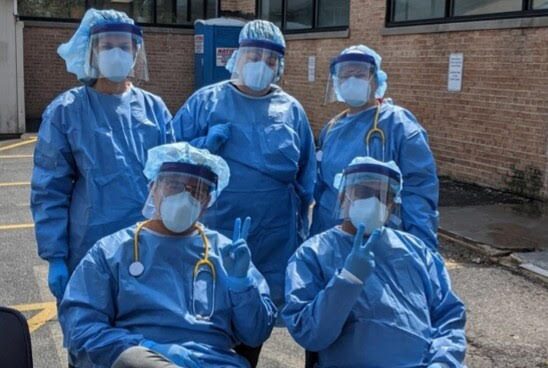With limited resources, Chicagoland Native American groups step up to help their own

American Indian Health Service workers pose during their first day of coronavirus testing, April 29.
May 6, 2020
As the coronavirus disproportionately affects Native American communities across the country, the Chicago American Indian Community Collaborative works to source and distribute immediate medical care, food and shelter to those in need.
Native communities have higher rates of underlying conditions, exacerbated by a severe lack of resources and information before and during the pandemic. According to the National Indian Health Board, only half of Native tribes had received information from state or federal governments about the coronavirus by mid-March, and less than 20 percent had received resources.
“This isn’t the first tragedy that Native Americans have experienced,” CAICC organizer Pamala Silas said. “We’ve survived a lot of moments in time. As human beings, we’re going to come up with new ways to survive and thrive.”
On April 27, the American Indian Health Service of Chicago started to offer COVID-19 testing. At least 50 percent of the tests were administered to Native and Indigenous people, according to RoxAnne Unabia, the interim executive director of the health service.
Although many of the patients the clinic serves are Indigenous, AIHS serves and is staffed by people of all backgrounds, Unabia said. She said they also have staff members who speak Spanish and can accommodate those who prefer or need that language resource.
“(AIHS workers) felt they had a duty to our community to offer the testing,” said Unabia. “That really made me happy because I knew that we would be able to provide a service to our community that was greatly needed.”
Unabia, who is from the Turtle Mountain Band of Chippewa Indians, said AIHS tested 18 people for COVID-19 on the first day. In the coming weeks, she is hoping to expand capacity to up to 100 tests per day.
After COVID-19 tests are administered, the Illinois Department of Public Health Division of Laboratories analyzes samples for results. When Gov. J.B. Pritzker added more testing sites at the end of April, laboratories became overwhelmed. At AIHS, results are supposed to arrive after three days but took over a week.
The clinic provides telehealth screenings on Mondays and Wednesdays, in addition to it’s scheduled in-person testing on Tuesdays and Thursdays.
All Native people can be tested for free at the health center, and prices can be adjusted or dropped for those who don’t have insurance.
“I felt we were filling a niche that no one else was just because I think there are members of the Native community who trust AIHS more than other clinics,” Unabia said.
Native communities continue to advocate for themselves and they have finally been recognized on a state level, according to Patty Loew, the director of the Northwestern Center for Native and Indigenous Research. Within the last week, the Illinois Department of Public Health included American Indian or Alaskan Native as a race demographic on statewide Covid-19 reports.
Loew, a member of the Bad River Band of Lake Superior Ojibwe, said the CAICC is an important organization because it connects and leverages the power of all the Native organizations and Native-serving institutions in the area to better provide for the community.
For Silas, taking action to help Native American communities in the Chicago area gives her hope amid the coronavirus pandemic.
“Moving forward, we have to hold on to that hope,” Silas said. “Take this moment to be future thinking and not just victimized or reactionary. Take care today, but don’t lose the dreams for tomorrow.”
Email: [email protected]
Twitter: @emmayarger

